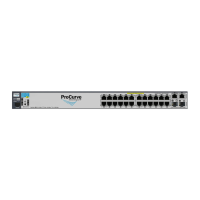299
1. Enter system view.
system-view
N/A
2. Enter BGP instance view or
BGP-VPN instance view.
• Enter BGP instance view:
bgp as-number [ instance
instance-name ]
• Enter BGP-VPN instance
view:
a. bgp as-number
[ instance
instance-name ]
b. ip vpn-instance
N/A
3. Ignore the ORIGINATOR_ID
attribute.
peer
{ group-name | ipv6-address
[ prefix-length ] }
ignore-originatorid
By default, BGP does not ignore
the ORIGINATOR_ID attribute.
Make sure this command does not
result in a routing loop.
After you execute this command,
BGP also ignores the
CLUSTER_LIST attribute.
Configuring a BGP confederation
BGP confederation provides another way to reduce IBGP connections in an AS.
A confederation contains sub-ASs. In each sub-AS, IBGP peers are fully meshed. Sub-ASs establish
EBGP connections in between.
Configuring a BGP confederation
After you split an AS into multiple sub-ASs, configure a router in a sub-AS as follows:
1. Enable BGP and specify the AS number of the router. For more information, see "Enabling
BGP."
2. Specify the confederation ID. From an outsider's perspective, the sub-ASs of the confederation
is a single AS, which is identified by the confederation ID.
3. If the router needs to establish EBGP connections to other sub-ASs, you must specify the
peering sub-ASs in the confederation.
A confederation can contain a maximum of 32 sub-ASs. The AS number of a sub-AS is effective only
in the confederation.
To configure a BGP confederation:
1. Enter system view.
system-view
N/A
2. Enter BGP instance view.
bgp
as-number [
instance
instance-name ]
N/A
3. Configure a confederation
ID.
confederation id
as-number
By default, no confederation ID is
configured.
4. Specify confederation peer
sub-ASs in the
confederation.
confederation peer-as
as-number-list
By default, no confederation peer
sub-ASs are specified.
